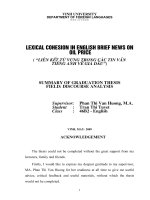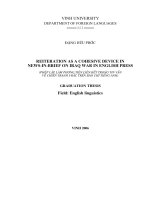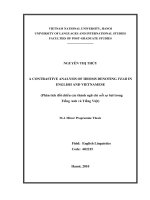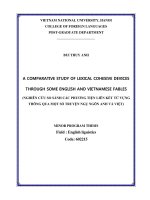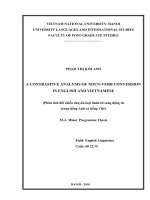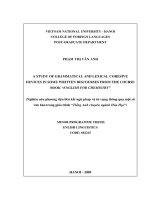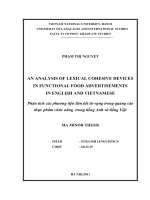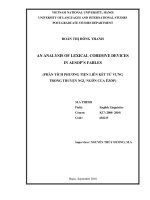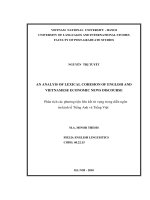an analysis of lexical cohesive devices in aesop's fables = phân tích phương tiện liên kết từ vựng trong truyện ngụ ngôn của êzốp
Bạn đang xem bản rút gọn của tài liệu. Xem và tải ngay bản đầy đủ của tài liệu tại đây (675.32 KB, 52 trang )
VIETNAM NATIONAL UNIVERSITY, HANOI
UNIVERSITY OF LANGUAGES AND INTERNATIONAL STUDIES
POST-GRADUATE STUDIES DEPARTMENT
ĐOÀN THỊ HỒNG THANH
AN ANALYSIS OF LEXICAL COHESIVE DEVICES
IN AESOP’S FABLES
(PHÂN TÍCH PHƯƠNG TIỆN LIÊN KẾT TỪ VỰNG
TRONG TRUYỆN NGỤ NGÔN CỦA ÊZỐP)
M.A THESIS
Field: English Linguistics
Course: K17 (2008- 2010)
Code: 602215
Supervisor: NGUYỄN THÚY HƯƠNG, M.A
Hanoi, September 2010
TABLE OF CONTENTS
PART 1: INTRODUCTION
1. Rationale
1
2. Aims of the study
2
3. Scope of the study
2
4. Methods of the study
2
5. Organization of the study
3
PART 2: DEVELOPMENT
Chapter 1: Theoretical background
4
1.1 Theory of discourse
4
1.1.1. Definition of discourse
4
1.1.2. Discourse versus Text
5
1.1.3. Discourse analysis
6
1.1.4. Discourse context
7
1.1.4.1 Context
7
1.1.4.2 Register
8
1.1.4.3 Genre
9
1.2 Cohesion
10
1.2.1 The concept of cohesion
10
1.2.2 Cohesion versus Coherence
11
1.2.3 Cohesion and discourse structure
12
1.2.4 Types of cohesion
12
1.2.4.1 Grammatical cohesion
13
1.2.4.2 Lexical cohesion
14
1.3 The narrative structure
15
1.4 Fables and its properties
16
1.4.1 Definition of fables
16
1.4.2 General characteristics of a fable
17
1.4.3 Generic structure of a fable
18
1.5 Introduction about Aesop and Aesop‟s fables
19
Chapter 2: Previous studies on lexical cohesive devices
21
Chapter 3: Lexical cohesive devices in the English version of Aesop’s fables
23
3.1 Reiteration
23
3.1.1 Repetition
23
3.1.2 Synonyms and near synonyms
27
3.1.3 Superordinates
28
3.2 Collocation
30
3.2.1 Lexical collocation
30
3.2.2 Grammatical collocation
32
3.3 Some concluding remarks
34
PART 3: CONCLUSION
1. Conclusion
36
2. Limitations
36
3. Implications
37
4. Suggestions for further studies
38
REFERENCES
39
APPENDIXES
Appendix 1: 25 chosen Aesop‟s fables for analysis of lexical cohesive devices
Appendix 2: Number of occurrence of lexical cohesive devices in 25 chosen
Aesop‟s fables for analysis
PART 1: INTRODUCTION
1. Rationale
The concept of discourse analysis was first studied in the late 1970s and 1980s from
different aspects and views of linguists. It has been paid much attention to by linguists since
its appearance. Halliday and Hasan (1976) put the emphasis on the social functions of
language. Schegloff, and Gail Jefferson (1974), whose exemplary study of turn-taking in
ordinary conversation made a first seminal contribution to the understanding of the sequential
organization of interaction. Then the concept continued to attract the attention of the late
twentieth century‟s linguists such as Cook (1989), Hatim and Mason (1990), Swales (1990),
Simpson (1997), etc. Through linguistic history, discourse analysis is found important in
providing insights into various aspects of language in use and therefore of great value to
language teaching. In reality, traditional language teaching seems to deal merely with
pronunciation, grammar and vocabulary of a language whereas the ability to produce a
grammatically correct sentence is not sufficient to use a language for powerful
communication. Discourse analysis came into being to put such knowledge of language into
action for communicating more successfully.
Cohesion and coherence, as sub-concepts of discourse analysis are greatly essential in
discourse construction and comprehension for communication. It is believed that the linguistic
features of great importance and interest are those of generic structure and cohesion. The
belief comes from the fact that these two factors make influential contribution in defining a
genre of discourse. As a component of cohesion, lexical cohesion is therefore worth being
investigated.
Fable which is defined as “a traditional short story that teaches moral lessons,
especially one with animals as characters” ( Oxford Advanced Learner‟s Dictionary, 2000:
470) is a genre of discourse .Of all the great authors of fables, Aesop is the earliest and best
known. His short and simple fables own their typical features distinguished from other genres
of discourse such as an article or a speech. Apart from its contribution to discourse as a genre,
fables are considered the valuable authentic materials that play a very important part in
students‟ cultural enrichment, language enrichment as well as personal involvement. In
language teaching, they represent great potentials for learners, especially learners at the
elementary level. Short and simple as fables are, they consequently seem to be the most
suitable authentic material for students‟ language proficiency at low level in rural areas. For
all these reasons, this research is carried out with the hope that an analysis of lexical cohesion
devices in Aesop‟s fables is helpful for the application of fables in English teaching and
learning in Vietnam.
2. Aims of the study
The research is intended to explore lexical cohesive devices as one discourse feature in
Aesop‟s fables. To be more specific, it aims at:
Identifying lexical cohesive devices used in Aesop‟s fables.
Realizing the role and contribution of lexical cohesive devices in constructing a
fable.
3. Scope of the study
The concept of cohesion is large. This study only focuses on the lexical cohesive
devices and explores the process in which coherence is achieved in the formal written genre of
fables. Short and simple fables of Aesop are studied to work out typical lexical cohesive
devices used in such genre of discourse. Data analyzed in the study is taken from 25 of
Aesop‟s fables chosen at random that were translated into English by Laura Gibbs for World‟s
Classics in 2002.
4. Methods of the study
To attain the aim of the study, the research is conducted in the following steps:
First, data necessary for the study are collected. Relevant theories are read and
extracted from books of great linguists such as Halliday and Hasan (1976), Cook (1989),
Brown and Yule ( 1983), Hatim and Mason ( 1990), Swales (1990). Aesop‟s fables are also
collected to serve the purpose of analyzing lexical cohesive devices used.
Second, a framework of lexical cohesive devices is set up in order to find out the
defining characteristics of fables as a genre of discourse. This is done on the ground of several
linguists‟ relevant theories and their viewpoints.
Third, three previous studies on lexical cohesive devices used in other genres of
discourse are reviewed for comparison with the use of lexical cohesive devices in fables.
Then, 25 selected fables are analyzed in terms of lexical cohesive devices: reiteration
and collocations. All the 25 fables are comprehensively analyzed to identify the lexical
cohesive devices used; their frequencies of occurrence are counted to make out the
significance level of each device to fables.
Last, some conclusions are drawn based on the data analysis and some implications for
English teaching at elementary level are also proposed.
The study is approached in both inductive and deductive ways; the three successive
methods chosen for the study can be named as descriptive, analytical and comparative.
5. Organization of the study
The study is composed of three parts: Introduction, Development and Conclusion.
The Introduction part presents the rationale, the aims, the scope, methods and
organization of the study.
The Developments part consists of three chapters:
Chapter 1 discusses the theoretical background related to discourse analysis. The concepts of
discourse and discourse analysis, the concept of genre and the distinction between genre and
register are made clear. The theoretical knowledge of cohesion and fables are also mentioned
in this chapter.
Chapter 2 reviews some previous studies on similar issue.
Chapter 3 focuses on the analysis of lexical cohesive devices employed in Aesop‟s fables.
The conclusion part reviews the study and ends it with some findings, implications for
teaching and learning, and suggestions for further studies.
PART 2: DEVELOPMENT
Chapter 1: Theoretical background
1.1 Theory of discourse
1.1.1 Definition of discourse
Since its introduction to modern science the term 'discourse' has taken various,
sometimes very broad meanings. Originally the word 'discourse' comes from Latin 'discursus'
which denotes 'conversation, speech'. The concept of discourse has been discussed for a long
time and linguists have different ways of understanding and defining it. To begin with,
Widdowson (1979:98) defines “discourse is a use of sentences to perform acts of
communication which cohere in large communicative unit, ultimately establishing a rhetorical
patterns which characterizes the piece of language as a whole as a kind of communication”.
Meanwhile, according to Cook (1989) “discourse is stretches of language perceived to be
meaningful, unified and purposeful”. His viewpoint was later shared with by Crystal (1992:25)
who states that “discourse is a continuous stretch of (especially spoken) language larger than a
sentence, often constituting a cohesive unit such as a sermon, an argument, a joke or a
narrative”. In Cook‟s view, such stretches of language can only be obtained if they are
considered “in their full textual, social, psychological context”. In basic sense, it may be
defined as “the language in use for communication” hence, discourse is supposed to be
meaningful (Cook, 1989).
There also exist a number of other linguists‟ viewpoints on discourse. In 1990, Hatim
and Mason contributed another definition that implied discourse is “a matter of expression of
attitude”; “a mode of speaking and writing which involves the participants in adopting a
particular on certain area of socio-cultural activity: racial discourse, scientific discourse,
domestic discourse. Then, seven years later, in 1997, in the book called “Language through
literature”, Simpson claimed discourse is “the term reserved for the highest level of linguistic
organization in language study”. It is also stated to refer to the “structure and function of
language beyond the level of sentence” by him.
To summarize, the concept of discourse is still under discussion, but basically, the
majority of linguists share a common view when defining it. It can be noted that their
definitions are expressed in different ways but all emphasize the two most important aspects of
discourse regarding its structure and function. In terms of structure, a discourse is a well-
formed organization above the level of a sentence; in terms of function, a discourse serves as a
means of communication.
1.1.2 Discourse versus Text
The distinction between the word “discourse” and “text” is still in controversy. As
observed, three trends of reasonizing have emerged to clarify the controversial distinction: For
some linguists, these two terms seem to be used almost interchangeably; Some see discourse
as a process and text as a product; and in others‟ view text is used for writing and discourse for
speech. Following the first trend is Halliday and Hasan (1976) who simply state: “we can
define text (discourse) in the simplest way perhaps by saying that it is language that is
functional”. They view text as employed to refer to discourse and see text as a “semantic unit”
characterized by cohesion. In their viewpoint, “a text is a passage of discourse which is
coherent in these two regards: it is coherent with respect to the context of situation and
therefore consistent in register; and it is coherent with respect to itself, and therefore cohesive”
(1976:23). Brown and Yule, Widdowson and Cook are the followers of the second trend. To
prove his points, Brown and Yule (1983:3, cited in Nunan, 1993:6) argue that text is “the
representation of discourse and the verbal record of a communication act”. Then,
Widdowson(1983:100) continues to point out the difference and the interrelationship between
the two as: “discourse is a communicative process by means of interaction. Its situational
outcome is a change in state of affairs: information is conveyed, intentions made clear, its
linguistic product is text”. In favor of the third trend is Crystal (1992: 72) who insists
discourse is a “continuous stretch of (especially spoken) language larger than a sentence,
whereas a text is “a piece of naturally occurring spoken, written or signed discourse identified
for purposes of analysis”.
In conclusion, there remains a disagreement about the meaning of the terms
“discourse” and “text”. It is, however, most agreed that both discourse and text need to be
defined in terms of “meaning” and that coherent text/piece of discourse are those that form a
meaningful one. To put it in another way, discourse is a general term to refer to all the act of
verbal communication, whereas text is simply a verbal record of the whole communicative
process (that is discourse) in which many situational factors are involved, it can be both
written and spoken, and there is no limit to the size of the text- “a text consists of one word or
it may be of considerable length” (Swales, 1990). Accordingly, text is purely linguistic, formal
object while discourse has both linguistic and non-linguistic property.
1.1.3. Discourse analysis
The first modern linguist who commenced the study of the relation of sentences and
coined the name 'discourse analysis', which afterwards denoted a branch of applied linguistics,
was Zellig Harris , an American linguist (Cook 1989:13). The emergence of this study is a
result of not only linguistic research, but also of researchers engaged in other fields of inquiry,
particularly sociology, psychology, anthropology and psychotherapy. Hence, it is seen as “a
new branch of linguistics which grew out of the work in different disciplines in the 1960s and
early 1970s, including linguistics, philosophy, logic, semiotics, psychology, anthropology”
(Van, 2000).
A significant contribution to the evolution of discourse analysis has been made by
British and American scholars. In Britain the examination of discourse turned towards the study
of the social functions of language. A thorough account of communication in various situations
such as debates, interviews, doctor-patient relations, paying close attention to the intonation of
people participating in talks as well as manners particular to circumstances was the first
concern of British scholars. Americans, on the other hand, focused on examining small
communities of people and their discourse in genuine circumstances and on conversation
analysis inspecting narratives in addition to talks and the behavior of speakers as well as
patterns repeating in given situations.
Being identified and studied properly in a large scale and continuously, discourse
analysis is understood as a primarily linguistic study examining the use of language by its
native population whose major concern is investigating language functions along with its
forms, produced both orally and in writing. Moreover, identification of linguistic qualities of
various genres, vital for their recognition and interpretation, together with cultural and social
aspects which support its comprehension, is the domain of discourse analysis. To put it in
another way, the branch of applied linguistics dealing with the examination of discourse
attempts to find patterns in communicative products as well as their correlation with the
circumstances in which they occur, which are not explainable at the grammatical level (Carter,
1993:23)
It was in 1973 that Discourse analysis was dealt perfectly and correctly in M.A.K
Halliday‟s functional approach to language. His approach is completely influential in British
discourse analysis with the emphasis on the social function and the thematic and informational
structure of speech and writing.
1.1.4 Discourse context
1.1.4.1 Context
In common sense, the Webster‟s Dictionary defines a context as “the whole situation,
the background or the environment relevant to a particular event, personality, creation, etc…”.
It is said to refer to the condition in which something exists or occurs. Linguistically, this is a
part of a discourse surrounding a word or passage that helps make its meaning clear.
The concept of context was first noticed in 1923 by Malinowski, an anthropologist
when he introduced the two terms “Context of situation” and “Context of culture”. According
to him, Context of situation refers to the environment of the context, including verbal
environment and the situation in which the text occurred while Context of culture deals with
the whole cultural background behind the participants in the interaction. His idea was later
taken up by Firth (1957) who placed great emphasis on the “social context”. He saw the
context of situation as crucial determinants of utterance meaning. Likewise, when reporting
the study of Malinowski (1923) Halliday and Hasan (1976) focused on context of situation and
described how it determines the kinds of meaning that are expressed with the general concepts
of field, mode and tenor. For some scholars, context seems just to be the minimal stretch of
language that helps to understand what is written or spoken. Halliday (1994:5) concluded that
context “refers to the events that are going on around when people speak and write”. Guy
Cook (1994) observes that context can be used in both a broad and a narrow sense: in the
narrow sense, it refers to knowledge of factors outside of the text under consideration; in the
broad sense it refers to knowledge of these factors and to knowledge of other parts under
consideration, sometimes referred to as “co-context”. The role of context in discourse analysis
was, as a result, then realized. David Nunan (1993:7) defines: “Context refers to the situation
giving use to the discourse and within which the discourse is embedded”. In other words,
context helps define reference; context helps establish and accumulate presuppositions;
context helps hearer detect conversational implicature; the discourse elaborates the context
and the context helps interpret the meaning of utterances in the discourse.
1.1.4.2 Register
Register, or context of situation as it is formally termed, is “ the set of meanings, the
configuration of semantic patterns, that are typically drawn upon under the specific conditions,
along with the words and structures that are used in the realization of these meanings"
(Halliday, 1978:23). It is concerned with the variables of field, tenor, and mode, and is a
useful abstraction which relates variations of language use to variations of social context.
Therefore, register analysis of linguistic texts, which enables us to uncover how language is
maneuvered to make meaning, has received popular application in (critical) discourse analysis
and (foreign) language teaching pedagogy.
Register is considered to supplement usefully for the concept of cohesion since “the
two together effectively define a text”, Halliday and Hasan (1976:22). This traces back to their
belief that “the register is the set of meanings, the configuration of semantic patterns that are
typically drawn upon under the specified conditions, along with the words and structures that
are used in the realization of these meanings”. In their viewpoint , register are discussed in
terms of the three features of context known as field, mode and tenor that are claimed to be “
highly general concept for describing how the context of situation determines the kinds of
meaning that are expressed”.
Field known as reference to “what is going on” ( i.e the field of activity) is “ the total
event, in which the text is functioning together with the purposive activity of speaker or writer;
it thus includes the subject matter as one element in it” (Halliday and Hasan , 1976:22). In
other words, field is the kind of language use which reflects the “purposive role” or the “social
function of the text” as Gregory and Carroll (1978) called, or it equals the setting and purpose
of the interaction.
Mode refers to the medium of the language activity including channel. Halliday and
Hasan (1976:22) defines mode as “the function of the text in the event, including therefore
both the channel taken by the language- spoken or written, extempore or prepared - and its
genre or rhetorical mode as narrative, didactive, persuasive, „phatic communion‟ and so on”.
Hatim (1990:50) later refers channel to “the vehicle through which communication takes
place, is an important aspect of mode. It transcends speech and writing to include other
communicative occurrence such as the telephone conversation, the essay, the business letter,
etc”.
Tenor refers to “the type of role interaction, the set of relevant social relations,
permanent and temporary among the participants involved” (Halliday and Hasan, 1976:22). It
is the tenor that “relays the relationship between the addresser and the addressee”.
Consequently, it is considered to refer to who is taking part, their statuses and roles and points
out what kind of relationship is among the participants.
In summary, field, mode and tenor collectively defines the context of situation of a
text. Nevertheless, there is overlap between all three variables. The values accruing from the
three dimensions of language use help us define and identify registers. The three variables are
interdependent: a given level of formality (tenor) influences and is influenced by a particular
level of technicality (field) in an appropriate channel of communication (mode) Hatim
(1990:51). These three register variables delineate the relationships between language function
and language form. In a specific way, a register is constituted by "the linguistic features which
are typically associated with a configuration of situational features- with particular values of
the field, mode and tenor" (Halliday, 1976:22). For example, the tenor of a text, which
concerns the relationship between the addresser and the addressee, can "be analyzed in terms
of basic distinctions such as polite-colloquial-intimate, on a scale of categories which range
from formal to informal" (Hatim and Mason, 1990:50). In the same vein, the mode of an
interaction which manifests the nature of the language code being used can be distinguished in
terms of, among other things, spoken and written.
1.1.4.3 Genre
Genre has been a controversial topic for a large number of linguists for years. It is
often employed to refer to different styles of literary discourse, such as sonnets, tragedies and
romances. Recently, the term has been adapted by functional linguists to refer to different
types of communicative events (Martin, 1984; Swales, 1990) - A communicative event is
defined by Nunan (1993: 17) as a “piece of oral or written interaction which contains a
complete message; the event itself may involve oral language (for example, a sermon, a casual
conversation) or written language (for example, a poem, a newspaper headlines). In 1985,
Martin offered a relatively simple definition with illustrations about genre: “Genres are how
things get done, when language is used to accomplish them. They range from literary to far
from literary forms: poems, narratives, expositions, lectures, seminars, recipes, manuals,
appointment making, service encounters, and news, broadcast and so on. The term genre is
used here to embrace each of the linguistically realized activity types which comprise so much
of our culture” (Martin 1985, cited in Swales 1990). Nonetheless, Martin‟s definition is
thought not to reveal much clearly the nature of genre, and how each genre differs from one
another. At the same time, Kress also contributed an idea that genres are “conventionalized
forms of text which reflects the functions and goals involved in particular social occasions as
well as the purposes of the participants in them” (Kress 1985:19, cited in Hatim and Mason,
1990:69). Genre, afterwards, was also studied further by Hatim and Mason themselves. Under
their look, “genres are viewed in terms of a set of features which we perceive as being
appropriate to a given social occasion”. This, to a great extent, means the conventions of the
social occasion are the key factor in determining genres; and there is a relationship between
elements of lexis, grammar, etc. and the social occasion associated with particular genres.
In a nutshell, whatever meaning genre is associated; it is still seen as one of the two
perspectives from which discourse is frequently studied beside register. It is a culturally and
linguistically distinct form of discourse.
1.2 Cohesion
1.2.1 The concept of cohesion
Halliday and Hasan were the two linguists who published good studies of cohesion
within English discourse. In the book called Cohesion in English (1976) they define cohesion
“is a semantic one; it refers to relation of meaning that exist within text, and that define as a
text”. It is understood, as contrasted with register, is not concerned with what a text means.
Rather, it refers to a set of meaning relations that exist within the text. According to them, the
function of cohesion is to relate one part of a text to another part of the same text. Cohesion is
the quality of well-formed discourses (texts) that gives them an internal unity, making them
“hang together”. Sentences flow smoothly from one to another within that discourse. This idea
is later taken up by Quirk (1985:1423) and restated by Cook (1994:29) who maintain cohesion
is “the network of lexical, grammatical and other relations which link various parts of a text”.
These relations or ties organize and, to some extent, create a text, for instance, by requiring
readers to interpret words and expressions by reference to other words and expressions in the
surrounding sentences and paragraphs. Cohesion is a surface relation and it connects together
the actual words and expressions that we can see or hear. It, therefore, may be defined as the
formal linguistic realization of semantic and pragmatic relations between clauses and
sentences in a text. In basic sense, cohesion refers to “the formal relationship that causes texts
to cohere or stick together. It is indicated by grammatical, logical and lexical relationships
found among or between the sentences of a text” (Hoa Ng., 2000: 23).
1.2.2 Cohesion versus Coherence
It is commonly known that the defining characteristic of discourse is “coherence”. The
study would introduce two typical linguists‟ views as a base for understanding it. Palmer
(1983) writes: “Coherence refers to the rhetorical devices, to ways of writing and speaking
that bring about order and unity and emphasis”. Nonetheless, the linguistic studies through
periods show disagreement on what cohesion is and how it defers from coherence for the fact
both the terms come from the verb “cohere” which means sticking together. Nunan (1993)
also states coherence is the “feeling that sequences of sentence or utterance seem to hang
together”. Coherence is thus understood as the extent to which discourse is perceived to hang
together.
Through linguistic history, some linguists have made great efforts to distinguish these
two terms. Richard et al (1992:62) point out: “cohesion is the grammatical and or lexical
relationship between the different elements of a text. This may be the relationship between
different sentences or different parts of a sentence”; and coherence is “the relationship which
links the meanings of utterance in a discourse or of the sentence in a text”. Correspondingly, if
cohesion refers to linguistic elements that make a discourse semantically coherent, then
coherence involves with what makes a text semantically meaningful. Cohesion is seen as one
of the ways of indicating coherence or in other words, cohesion is the realization of coherence.
From Richard‟s outlook, cohesion exists within text and adds to the coherence of text and
coherence is something created by the reader in the act of reading the text. It may be useful to
think of coherence as something the reader establishes or hopes to establish in the process of
reading connected discourse. As a continuation, Larson later claims: “the determination of
coherence is fundamentally an interpretation by a reader. It is part of a transaction between
text and reader, between reader‟s world and the writer‟s language”; “coherence is both text-
related and a reader-related phenomenon”.
To conclude, cohesion and coherence are similar in that both concern the way stretches
of language are connected to each other, yet these two aspects of discourse are interrelated,
which make a text or discourse coherent and different from random ones. Coherence is
believed to be embodied by a system of cohesive devices and cohesion is mainly used to
ensure coherence.
1.2.3 Cohesion and discourse structure
Halliday and Hasan (1976:10) define discourse structure is a type of structure - the
structure of some postulated unit higher than a sentence such as a paragraph, or some larger
entity such as episode or topic unit. In their viewpoint, the concept of cohesion is to set up to
account for relations in discourse, but in rather a different way, without the implication there is
some structural unit that is above the sentences. Cohesion, in this view, refers to the range of
possibilities that exist for linking something with what has been previously mentioned. As a
matter of fact, it is the sentence that is the pivotal entity here- whatever is put together within
one sentence is part of a text- we can interpret cohesion, in practice, as the set of semantic
resources for linking a sentence with what have been mentioned before. From the standpoints
of Halliday and Hasan: “the determinant of whether a set of sentences do or do not constitute a
text depends on cohesive relationship within and between the sentences”. The relation
between them creates cohesion. Added to this, they assure: “We have to show how sentences,
which are structurally independent of one another, may be linked together through particular
features of their interpretation; and it is for this that the concept of cohesion is required”.
1.2.4 Types of cohesion
The seminal work on cohesion done by Halliday and Hasan (1976) has been found to
be a starting point for any research dealing with cohesion. In their viewpoint, the classification
of cohesion is based on the linguistic form. Some forms of cohesion are realized through
grammar and others through the vocabulary. Cohesion is a semantic relation, but it is realized
through the lexico – grammatical system. They also introduce the most comprehensive
description and analysis of cohesive devices which identifies five different types including
Reference, Substitution, Ellipses, Conjunction and Lexical cohesion. According to them,
Reference, Substitution, Ellipses are grammatical cohesion in that they involve a closed-
system items. Lexical cohesion involves a kind of choice that is open-ended. Conjunction is on
the borderline of grammatical and lexical since conjunctive items are grammatical, but some
are lexical as well- Halliday and Hasan (1976: 303)
There remain other ideas in naming, classifying or grouping types of cohesion. The
study is based on the two great linguists‟ classification for its simplicity and clear
understandability. As cohesion is realized through both grammar and vocabulary, it has been
classified into two kinds: grammatical cohesion and lexical cohesion which work together to
create a text.
1.2.4.1 Grammatical cohesion
In linguistics, grammar refers to the logical and structural rules that govern the
composition of sentences, phrases, and words in any given natural language. Grammatical
cohesion, hence, refers to the structural content. It can be defined as the surface marking in
written discourse and between sentences and turns in speech. For this reason, grammatical
cohesion can be grouped into 4 types: reference, substitution, ellipsis and conjunction.
Reference: is the use of words which do not have meanings of their own, such as
pronouns and articles. To infer their meaning the reader has to refer them to something else
that appears in the text.
Substitution: in order to avoid repeating the same word several times in one paragraph
it is replaced, most often by one, do or so. In other words, substitution is a relation in the
wording rather than meaning; they are alternate words used in the place of a repetition of a
particular item.
Ellipsis: is very similar to substitution, however, it replaces a phrase by a gap. It
equals to the omission of noun, verb, or a clause on the assumption that it is understood from
the linguistic context.
Conjunction: specifies the relationship between clauses, or sentences. Most frequent
relations of sentences are: addition (and, moreover e.g.), temporality (afterwards, next…) and
causality (because, since…).
1.2.4.2 Lexical cohesion
Lexical cohesion is “phoric” cohesion that is established through the structure of the
lexis or vocabulary and hence (like substitution) at the lexicogrammatical level.
Lexical cohesion involves either the reiteration of an item –repetition of an item, or the
use of a synonym, near synonym, or superordinate term. Lexical cohesion could also be used
in reference to lexical collocation. In other words, lexical cohesion embraces two distinct
though related aspects which we referred to as Reiteration and Collocation.
Reiteration: Halliday and Hasan, (1976: 278) point out reiteration is “a form of lexical
cohesion which involves the repetition of a lexical item, at one end of the scale; the use of a
general word to refer back to a lexical item, at the other end of the scale, and a number of
things in between – the use of a synonym, near synonym, or superordinate”. They also explain
again in the next page (279): “when we talk about reiteration , we are including not only the
repetition of the same lexical item but also the occurrence of a related item, which may be
anything from a synonym or near synonym of the original to a general word dominating the
entire class”. Then, they categorize any instance of reiteration may be (a) the same word(
repetition) (b) a synonym or near- synonym, (c) a superordinate or (d) a general word.
Collocation: J.R. Firth (1890-1960), a British linguist, is usually considered to be the
"father" of collocation. It was also he that first used the term "collocation" in its linguistic
sense. In the words of Halliday and Hasan (1976) collocation represents “the most
problematical part of lexical cohesion”. Collocation is the type of cohesion that is achieved
through the association of lexical items that regularly co-occur. Mc Carthy (1991:65), in the
meanwhile, argues: “It‟s debatable whether collocation properly belongs to the notion of
lexical cohesion, since collocation only refers to the probability that lexical items will co-
occur, and is not a semantic relation between words.
The understanding of reiteration and collocation will be discussed deeper in the section
3.3 of the study with illustration from Aesop‟s fables in the English version.
1.3 The narrative structure
Labov and Waletzky (1967:41) first presented the diagrammatic representation of the
internal structure of a narrative with the four components including orientation; complication;
evaluation and resolution. Afterwards, Labov (1972) introduces „abstract‟ before orientation
arguing that the addition was necessary since „it is not uncommon for narrators to begin with
one or two clauses summarizing the whole story‟. He hence presented the basic structure of a
narrative in a model composed of six ordered units, namely abstract, orientation, complicating
action, evaluation, result or resolution and (optional) coda - (Labov 1972: 363)
Orientation: introduces the reader to significant background details in a story such as
characters, time, or setting. In „orientation‟, reference is made to the identification in some
way of the time, place, persons and their activity or the situation in which they find themselves
all within the first several narrative clauses. In addition, orientation clauses may provide
background information such as knowledge that characters in the story may or may not have,
mood of characters or other information that is necessary to understanding the narrative.
Complication: The story escalates as the complicating action and complication
develops and reaches a high point in the evaluation.
Evaluation: where the significance of the story is clear. The term „high point‟ is used
to refer to the point at which a story builds through the recapitulation of events and then often
suspends the action at this crisis point while the importance of the story is highlighted. Labov
(1972) argues that „evaluation‟ is possibly the most important part of a narrative that has
unfortunately been ignored by many in the analysis of the narrative. Evaluation is “the means
used by the narrator to indicate the point of the narrative, its raison d‟être: why it was told, and
what the narrator is getting at.” (Labov 1972:366).
Resolution: Subsequently, resolution of the crisis is provided through more
recapitulation of events. This means that narratives are organized around one or more key
points that are stressed by the narrator.
Coda: refers to the way a narrative is concluded. Codas have the property of bridging
the gap between the moment of time at the end of the narrative proper and the present. They
bring the narrator and the listener back to the point at which they entered the narrative. The
coda can thus be seen as a means of solving the problem of indicating the end of a „turn‟ at
speaking (Labov, 1972: 366). Codas are structural in function and serve to signal the end of a
narrative.
In summary it is suggested that a complete narrative begin with an abstract, followed by
an orientation, it then proceeds to the complicating action, evaluation and resolution. It then
returns the listener to the present time with the coda.
1.4 Fables and its properties
1.4.1 Definition of fables
The word "fable" comes from the Latin "fabula" (a "story"), itself derived from "fari"
("to speak") with the -ula suffix that signifies "little": hence, a "little story". In its original
sense "fable" denotes a brief, succinct story that is meant to impart a moral lesson, but, in a
pejorative sense, a "fable" may be a deliberately invented or falsified account of an event or
circumstance. An author of fables is termed a "fabulist," and the word "fabulous," strictly
speaking, "pertains to a fable or fables." In recent decades, however, "fabulous" has come
frequently to be used in the quite different meaning of "excellent" or "outstanding"
A fable is shortly defined, in Oxford Advanced Learner‟s Dictionary (2000), as “a
traditional short story that teaches a moral lesson, especially one with animals as characters”.
The Columbia Electronic Encyclopedia (6
th
edition) also gives another definition of a fable : “
a brief allegorical narrative, in verse or prose, which illustrates a moral thesis or satirizing
human beings; the characters of a fable are usually animals who talk and act like people while
retaining their animals traits”. Also, from Wikipedia, the free encyclopedia, a fable is “a
succinct story, in prose or verse, that features animals, plants, inanimate objects, or forces of
nature which are anthropomorphized (given human qualities), and that illustrates a moral
lesson (a "moral"), which may at the end be expressed explicitly in a pithy maxim”. Expressed
in different ways as it is, a fable can be easily memorized as very short tales containing some
moral teaching with animals as characters.
1.4.2 General characteristics of a fable
A fable sets out to teach the reader or listener a lesson they should learn about life. The
narrative drives towards the closing moral statement and it is the clear presence of a moral that
distinguishes fables from other folk tales. Accordingly, fables can be described as a didactic
mode of literature. It is one of the most enduring forms of folk literature, spread abroad so can
be found in the literature of almost every country. As a genre of discourse in traditional
literature, fables own the characteristics regarding their theme, plot and structure, character,
style as follows:
Theme: Although they use many of the typical themes, characters and settings of
traditional stories, fables have a very specific purpose that strongly influences their content. A
fable sets out to teach the reader or listener a lesson they should learn about life. The narrative
drives towards the closing moral statement, the fable‟s theme: the early bird gets the worm,
where there‟s a will there‟s a way, work hard and always plan ahead for lean times, charity is a
virtue. The clear presence of a moral distinguishes fables from other folk tales.
Plot and structure: Plot is overtly fictitious as the point of the story is its message,
rather than an attempt to convince the reader of a real setting or characters. There is a shared
understanding between storyteller and audience that the events told did not actually happen.
They are used as a means to an end, a narrative metaphor for the ethical truth being promoted.
For this reason, fables do not carry any non-essential narrative baggage. There are
usually few characters and often only two who are portrayed as simple stereotypes rather than
multidimensional heroes or villains. Narrative structure is short (sometimes just a few
sentences) and simple and there is limited use of description. Action and dialogue are used to
move the story on because the all-important moral is most clearly evident in what the main
characters do and say.
Character: The main characters are often named in the title (the town mouse and the
country mouse, the North Wind and the Sun) and they are also frequently animals, another
subtle way of signaling the fictional, „fabulous‟ nature of the story and its serious purpose.
Animal characters speak and behave like human beings, allowing the storyteller to make
cautionary points about human behavior without pointing the finger at real people.
Style: Many fables use the rich vocabulary, imagery and patterned language common
in traditional tales but generally speaking, the shorter the fable, the more simple its use of
language. In these short texts, use of vocabulary is often pared down and concise.
1.4.3 Generic structure of a fable
As it is noticed, the structure of a fable is typically the simplest kind of narrative with a
beginning, a complication and a resolution. Two characters (often animals) meet, an event
occurs and they go on their way with one of them having learned an important lesson about
life. For such simplicity, the generic structure of a fable seem to lack some components in
comparison with the structure of a natural narrative suggested by Labov(1972) as mentioned
in 1.3.
To be more specific, there, in a fable, generally, exists a component that provides a
brief introduction of the main characters that are about to appear constantly during the
narrative and that sets the scene for the story to happen. This opening section is differently
labeled “orientation” (Labov, 1972), “stage” (Longarce 1976),” setting” (Rumehart, 1975) or
“placement” (Hasan, 1984). This study would follow the suggestion of Labov (1972) and refer
to it as Orientation. The orientation is then followed by the so called Event Chain- series of
specific events that develop the content of the fable. The event chain itself is composed of
three subcomponents namely Initiating event, Sequent event and Final event. These events are
normally arranged in chronological order; one event is strictly followed by another in terms of
chronological order, even when there are no explicit indicators of adverbials of time. In the
long run, a fable may end with a component that is referred to as Coda. Coda provides a
concrete verbal moral lesson withdrawn or inferred from the story. A fable, however, is not
always supposed to include all the three components and isolate them clearly. It can begin
with either orientation or initiating event, and end without a coda sometimes. By and large, the
generic structure of a fable can be viewed through the following illustration:
[Orientation]
Event chain (Initiating event-> Sequent event-> Final event)
[Coda]
Note: The square brackets in the figure indicate optional elements in a fable.
The arrows show the logical sequence of each element.
1.5 Introduction about Aesop and Aesop’s fables.
Aesop was claimed to be a slave in ancient Greece between 620 and 560 BC, who was
famed as a storyteller. However, the place of Aesop's birth was and still is disputed: Thrace,
Phrygia, Egypt, Ethiopia, Samos, Athens, Sardis, and Amorium all claimed the honor. Little is
known about him from credible records, except that he was at one point freed from slavery
and that he eventually died in Delphi. Only after his death, collections of his stories were
made. And because of his fame, he was credited with the authorship of a great many fables
whose real authors were unknown. In fact, the obscurity shrouding his life has led some
scholars to deny his existence altogether. The modern view is that Aesop probably did not
solely compose all those fables attributed to him, if he even existed at all. Also, present
scholarship reveals fables and proverbs of "Aesopic" form existing in both ancient Sumer and
Akkad, as early as the second millennium BCE. Therefore, at their most ancient roots, the
fables of Aesop are composed in a literary format which appears first not in Ancient Greece or
Ancient Egypt, but instead in ancient Sumer and Akkad and most probably in Ancient India.
The so called Aesop's Fables or Aespica refers to a collection of fables credited to
Aesop. It evolved from an uncertain time between 3rd century BC and 3rd century AD. Then,
Aesop's Fables have become a blanket term for collections of brief fables, especially beast
fables involving anthropomorphic animals. The first extensive translation of Aesop into Latin
was done in the 1st century AD. Later, its translation and transmission evolved through years
and spread widely. Some adaptations have been made and even, some authors took the
inspiration from Aesop's Fables to write their own fables.
Whatever it is disputed, Aesop's Fables as it is called are the earliest and best known.
The fables remain a popular choice for moral education of children today. Many stories
included in Aesop's Fables, such as The Fox and the Grapes (from which the idiom "sour
grapes" was derived), The Tortoise and the Hare, The North Wind and the Sun, The Boy Who
Cried Wolf and The Ant and the Grasshopper are well-known throughout the world and
always worth reading for generations.
Chapter 2: Previous studies on lexical cohesive devices
The theoretical knowledge of the study is based on the viewpoints from different
prospects of great linguists as well as the ideas extracted from the researches done beforehand.
In this chapter, the author would like to review some researches related to the study of
previous authors as reference for carrying out the study/ later comparing and analyzing the
data of lexical cohesion in English version of Aesop‟s fables. In reality, researches done on
cohesion, particularly lexical cohesive devices of a certain genre of discourse are numerous;
therefore, it is hard to cover all. For this reason, only some researches implemented in
Vietnam within restricted area of the Vietnam National University are reviewed in a very
small scale.
The first research is an M.A thesis by Phuong To Tam (2003) entitled “An analysis of
coherence and cohesion and a contrastive analysis of lexical cohesive devices in English and
Vietnamese”. The data for this thesis is from a chapter (chapter 5) on International Trade in
the textbook “International Business- An integrated Approach” by John J.Wild, Kenneth
L.Wild and Jerry C.Y.Han (1998). The attention of the study is paid to considering contrastive
analysis of lexical cohesive devices (including reiteration and collocation) in English (source
language) in the original textbook and their equivalents in Vietnamese (target language) in the
translation version. The author then attempts to collect data in both English and Vietnamese to
see the frequencies, similarities and differences of each device and sub-device of lexical
cohesive devices in the discourse of both languages. In the research, reiteration is viewed
noticeably in terms of repetition, synonyms and antonyms .In the first place, the repetition is
categorized into noun+ noun phrases, proper names, other content words and titles, and the
analysis shows repetition is most often seen with nouns and nouns phrases, other types of
repetition account for a rather small portion in total ranging from 9.6% to 15%; synonyms and
antonyms are analyzed with their types of nouns, verb and adjectives. Collocation is also a
focus for analysis; the author primarily classifies collocation (in terms of structure) into two
main types: Noun-collocation with noun as element and others without the presence of a noun,
and come to conclusion that noun-collocation dominates all other types of collocations with up
to 75%.
The next research is another M.A thesis by Le Thi Mai Hien (2004) entitled “An
analysis of cohesive devices in English application letter”. The process of searching on twenty
English application letters enables her to reach the results of the frequency of occurrence of
lexical cohesive devices, reiteration and collocation to say exactly in English application
letters. The data present Repetition in English application letters occupies the first among the
four kinds of reiteration; superordinates rank the second with a considerably high percentage
of 24.9%; synonyms and near-synonyms account for nearly the same portion, which is
respectively 10.4% and 11.3%. The data analysis helps the authors come to the final
conclusion that repetition is by far the most frequently used lexical cohesive devices in the
genre of application letter.
The last research reviewed is Nguyen Thi Thao‟s (2005) M.A thesis of “Some
discourse features of English fables”. Different from the two above studies, this research
seems to cover a broader aspect of discourse. The author desires to deal with not one but some
features of discourse in a certain genre. Generic structure and cohesive devices are the two
striking features discussed in the study. The author shows the normal generic structure of a
fable that is constructed with the Orientation, the Event Chain and the Coda at the end.
Cohesive devices are also exploited regarding its constituents namely reference, substitution,
conjunction (grammatical cohesive devices) and lexical cohesive devices. It is concluded that
in terms of grammatical cohesive devices, Reference, account for the highest frequencies of
use, whereas, in terms of lexical cohesive devices, Repetition contributes the biggest
proportion in English fables.
In conclusion, it is noticed that a number of researches on cohesive devices and
particularly on lexical cohesive devices have been done in various discourses and genres.
Nevertheless, none has been done on Aesop‟s fables in the English versions. The results of the
previous studies are helpful for making comparison in this study. It is hoped the study shares
some new facts and figures with the previous ones and reveal clear distinction in the use of
lexical cohesive devices in a fable and in other kind of texts.
